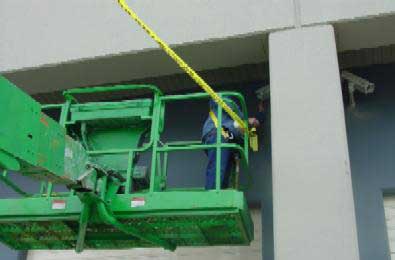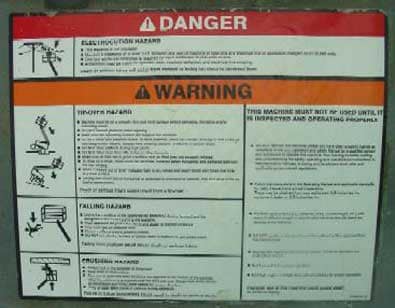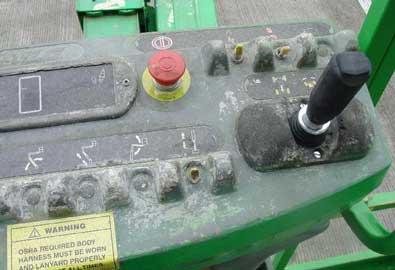Technician Crushed When Aerial Platform Lift Engaged
Oregon Case Report: 05OR007
February 9 , 2006
Summary
On April 9, 2005, a 51-year-old security systems technician for a freight shipping company was killed while operating a Gradall aerial platform. The technician was working alone, using the rented aerial platform (an articulating boom lift) to install security camera equipment above the doors of a freight terminal. After completing the wiring of one camera, the technician moved the lift to a second door, and raised the platform to work on the camera there. He apparently engaged the lift control while he was bent over the platform railing, and his head struck the door overhang. The platform continued to rise, pinning and crushing the bent-over technician between the roof overhang and the platform railing. He was discovered by a truck driver, who lowered the platform and called for emergency assistance. Paramedics confirmed the victim dead at the scene.

|
|
View of aerial platform during OR-OSHA investigation.
Photo courtesy of Oregon Occupational Safety & Health Administration (OR-OSHA). |
Recommendations
- All workers using mobile machinery should have adequate training on the proper use and safe operation of the equipment.
- Read and follow the manufacturer’s operating manual before using machinery.
Introduction
On April 9, 2005, a 51-year-old security systems technician with a freight shipping company was killed while operating a rented JLG Gradall articulating boom lift – a type of aerial platform – to install security cameras above the doors of a freight terminal. OR-FACE received notification of the incident on April 11, 2005. The employer did not grant permission for an OR-FACE site investigation. This report is based on information from the local police bureau, the medical examiner’s office, and Oregon OSHA.
The employer provides scheduled surface transportation of air freight for various air couriers, with a network of 80 terminals located throughout the USA and Canada. The firm employs a security systems technician to travel throughout its terminal network to install and maintain security cameras. Additional cameras were being installed over an Oregon terminal’s bay doors, because of increased criminal activity during nonoperating hours.
The security system technician traveled and worked alone, using locally rented equipment. The technician had 10 years of experience operating aerial platforms; but since he traveled and worked alone, there was no supervision of his use of equipment or personal protection devices. In addition, there is no indication he was trained on the particular Gradall aerial platform used on the day of the incident. The technician rented the equipment by phone, and it was delivered to the site while he was still in transit. No safety harness, lanyard, or hard hat was requested with the delivery. Neither the employer nor the rental company provided training on the specific equipment.
Investigation
The day before the incident, the security technician installed wiring throughout the terminal for the cameras. On the day of the incident, he installed one camera over a dock door, and then moved the lift to a second bay door. Markings indicate that he hit a wall while making a turn, perhaps due to unfamiliarity with the equipment. Once in position, the technician raised the platform over the second bay door.

|
|
The warning label on the aerial platform illustrates the hazards of electrocution, falling, or striking an overhead obstacle.
Photo courtesy of Oregon Occupational Safety & Health Administration (OR-OSHA). |
The technician may have had difficulty with the operation of the lift’s foot pedal and control lever. He apparently depressed the foot pedal and the control lever, and was leaning over the platform railing when the mechanism engaged. When the lift rose, the technician’s head hit the roof overhang. The lift continued to rise, pinning the bent-over technician between the base of the roof overhang and the lift railing.
The Gradall operating instructions state that the controls will cease to function if the foot pedal is not depressed for a period of 7 seconds, and will not respond for 2 seconds after being reengaged. There is also a 2-second delay from leaving the control to stop, which equals about 9 in. of travel. Inspection of the machine by the rental company following the incident found no mechanical malfunction, but a separate inspection found the lift mechanism hesitated slightly longer than expected.

|
|
The lift mechanism involves both hand and foot controls. |
There were no witnesses to the event. About 45 minutes after the technician had begun work, a truck driver delivering a trailer entered the terminal dock area. The driver saw the technician slumped face forward over the top rail of the platform, pinned against the roof overhang and not moving. The truck driver lowered the still-running lift about 10 ft, and called for emergency services. Paramedics confirmed the victim dead at the scene.
Investigators concluded the technician lacked training in the operation of the Gradall lift by evidence of (a) the lift hitting the terminal wall, (b) required safety equipment was not worn, and (c) no training on the lift was documented from the employer or the rental company.
Cause of Death
Traumatic Compression Asphyxia
Recommendations/Discussion
Recommendation #1: All workers using mobile machinery should have adequate training on the proper use and safe operation of the equipment.
Although the technician in this incident had years of experience using mobile aerial lifts, he may not have been familiar with the controls of this particular model. There was no evidence that the employer had provided training, or had provisions for retraining and testing to maintain competency.
Training on an aerial platform should include inspection of equipment and review of maintenance records prior to use; safe operation of lift controls; limitations of different types of equipment; how to work in tight spaces and avoid overhead obstacles; and procedures in case of emergency. Safe operation includes wearing personal protection equipment such as appropriate fall and head protection.
Training must be provided by a qualified individual. Employers should provide this training upon assignment to work with each type of mobile machinery upon delivery of new, leased, or rented equipment. Employers should also ensure that operator proficiency and safe work practices are maintained. This is especially important for workers who work alone. Employers should evaluate operators’ performance at least every 3 years.
Recommendation #2: Read and follow the manufacturer’s operating manual before using machinery.
The manufacturer’s operating manual, containing operating and maintenance instructions, is required to be with the equipment, as provided by ANSI/SIA A92.5 (1995). In this case, the operating manual and the ANSI manual were attached to the lift. The lift was posted: “Operator required to read and understand operation and ANSI manuals before operating,” and the bucket was posted with required body harness and attached lanyard requirements. The Gradall operating manual outlines user responsibilities and operator training, including safety precautions, use and limitations of the controls in the platform and at the ground, emergency controls, safety systems, recognition of a malfunction, use of fall and head protection, and machine operation around overhead obstructions, other moving equipment, and obstacles.
References
- Center to Protect Workers’ Rights. (n.d.) Electronic Library of Construction Occupational Safety & Health. Search on “aerial lifts.” Online resource: www.elcosh.org/index.phpexternal icon (Link updated 4/1/2013)
- Occupational Safety and Health Administration. Powered industrial trucks (29 CFR 1910.178). Regulations online: www.osha.govexternal icon. Search “Regulations” for powered industrial trucks.
- Occupational Safety and Health Administration. (1999). Powered platforms, manlifts, and vehicle-mounted work platforms. Regulations available online: 29 CFR 1910, Subpart Fexternal icon (1910.66 to1910.68).
- Occupational Safety and Health Administration. (1999). Scaffolds. Regulations available online:29 CFR 1926, Subpart Lexternal icon (1926.450 to 1926.454); Standard 1926.453 addresses aerial lifts.
- Occupational Safety and Health Administration. (2000). Fall protection, training, inspection & design requirements of aerial lifts and scissor lifts/scaffolds. Go to Laws & Regulations, Interpretations; search on “aerial lifts.” Online resource: www.osha.gov/index.htmlexternal icon
- Oregon Occupational Safety and Health Division (OR-OSHA). (n.d.). Search on “aerial lifts” for miscellaneous technical notes, letters, interpretations, and program directives. Online resource: www.cbs.state.or.us/external/osha/external icon
- Los Alamos National Laboratories. (2005). Aerial lift safety. Example of safety program. Available online: www.llnl.gov/es_and_h/hsm/doc_15.05/doc15-05.html (Link no longer valid, 12/11/2007)
- Center for Research on Occupational and Environmental Toxicology. Powered industrial trucks. Online information resource: www.croetweb.comexternal icon. Search for powered industrial trucks.
Oregon FACE Program
To contact Oregon State FACE program personnel regarding State-based FACE reports, please use information listed on the Contact Sheet on the NIOSH FACE web site. Please contact In-house FACE program personnel regarding In-house FACE reports and to gain assistance when State-FACE program personnel cannot be reached.
CROET at OHSU performs OR-FACE investigations through a cooperative agreement with the National Institute for Occupational Safety and Health (NIOSH), Division of Safety Research. The goal of these evaluations is to prevent fatal work injuries in the future by studying the work environment, the worker, the task, the tools, the fatal energy exchange, and the role of management in controlling how these factors interact.
Oregon FACE reports are for information, research, or occupational injury control only. Safety and health practices may have changed since the investigation was conducted and the report was completed. Persons needing regulatory compliance information should consult the appropriate regulatory agency.

